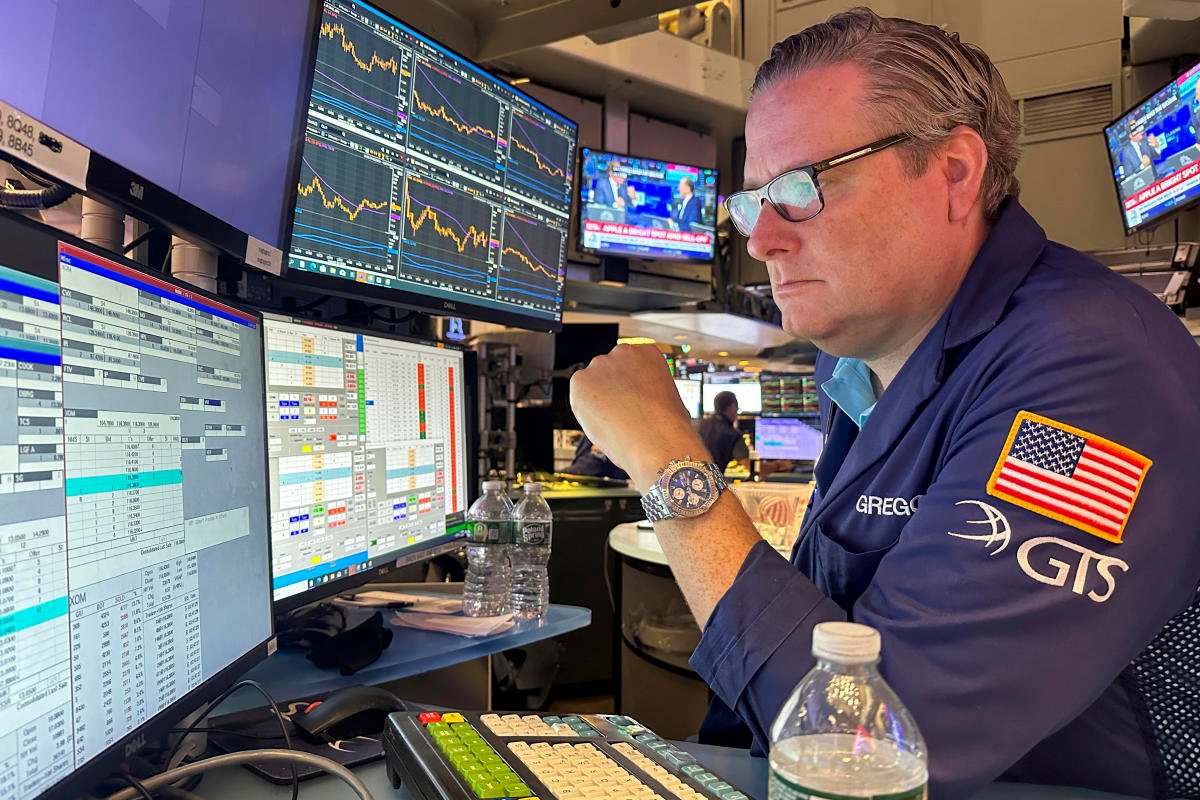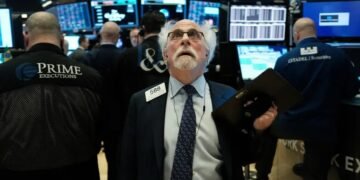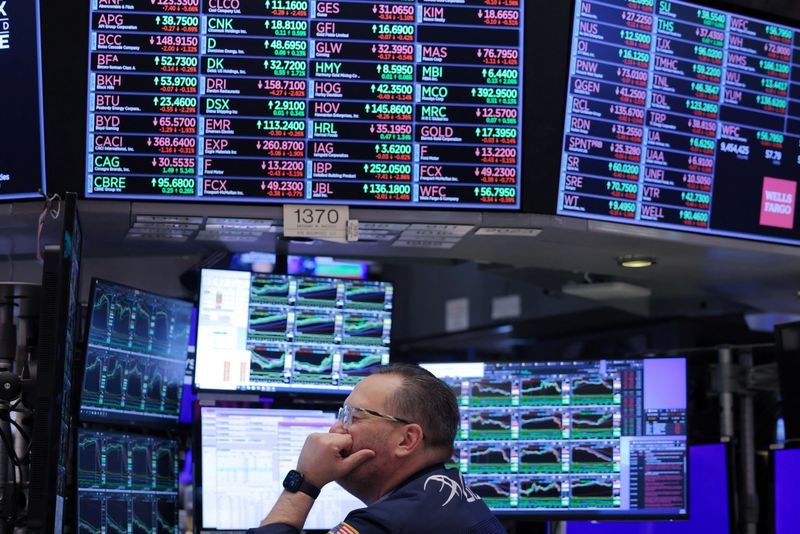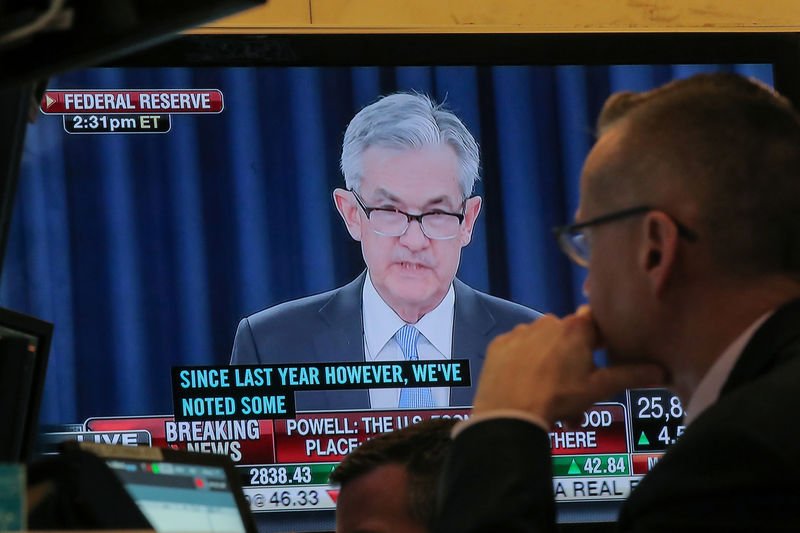Wall Street’s stock sell-off intensified in a major way Monday as concerns mounted over the health of the US economy. The Dow Jones Industrial Average (^DJI) fell over 1,000 points. The Nasdaq Composite (^IXIC) was crushed by more than 3.4%. The S&P 500’s (^GSPC) losses cascaded nearly 3% in its worst day since 2022, capping its worst start to any month since 2002.
Wall Street’s “fear gauge” — the CBOE Volatility Index (^VIX) — touched its highest level since the early days of the COVID-19 pandemic, before retreating. Treasury yields fell, with the benchmark 10-year Treasury yield (^TNX) hovering near 3.8%.
The global stock market rapidly sold off after Friday’s lackluster US jobs report added to concerns about the economy and whether the Federal Reserve had waited too long to begin cutting interest rates. Of note, almost 100% of bets are on the central bank to cut rates by 0.5% by its September meeting, according to the CME FedWatch tool.
Some of the biggest companies in the stock market saw their values plummet. Apple (AAPL) declined about 5% amid the sell-off and news that Berkshire Hathaway (BRK-B) had cut its stake in the company in half. Nvidia (NVDA) pulled back over 6%. Tesla (TSLA) fell more than 4%.
Crypto also took a beating, with bitcoin (BTC-USD) sinking more than 10% to creep back toward the $54,000 level.
The concerns spread throughout the world, as well. Traders in Asia greeted the week with a similar sell-off, as Japan’s Nikkei 225 (^N225) was routed by more than 12% in its biggest-ever daily loss after a surprise interest rate hike from the Bank of Japan last week.
The sharp rise in the Japanese yen against the US dollar has spurred heavy selling as speculators who had borrowed money at Japan’s near-0% interest rate to buy US risk assets have been liquidating their holdings.
The US market is headed into a quieter week of data and earnings. With the jobs market still in focus, weekly unemployment claims due Thursday will take a bigger spotlight than usual.
LIVE COVERAGE IS OVER14 updates
-
Dow drops over 1000 points as tech leads losses in market plunge, Nasdaq sinks more than 3%
The major averages plunged on Monday as the recent market rout intensified.
The Dow Jones Industrial Average (^DJI) lost over 1000 points. The Nasdaq Composite (^IXIC) declined roughly more than 3.4%, extending its losses from last week when the tech-heavy index entered into a correction. The S&P 500 (^GSPC) lost almost 3% to see its worst start of any month since 2002.
All eleven of the S&P 500 sectors ended the session in red territory, with Technology (XLK) stocks down the most as fears of a recession creeped into the market
Nvidia (NVDA) shares fell along with the rest of the “Magnificent Seven” stocks led the broader market plunge, collectively losing roughly $652 billion in market cap.
Not much was spared from the chopping block on Monday. Commodities sold off, as did cryptocurrencies.
All sectors ended the session in red territory on Monday. -
Markets are rapidly pricing in more interest rate cuts
A slew of weaker-than-expected economic dataincluding a surprise uptick in the unemployment rate triggering a closely watched recession indicator, has sent markets into a tailspin.
Investors have now decided that bad economic news is bad news for markets as the growth trajectory comes into closer focus. Economists largely agree that the risks to the Federal Reserve holding interest rates too high and potentially stunting economic growth have risen.
But there isn’t consensus on how quickly and swiftly the Fed needs to adjust its policy to address this risk. As of Monday afternoon, markets are pricing in more than five interest rate cuts by the end of the Fed’s January 2025 meeting, roughly two more cuts than markets had priced less than a week ago on July 31.
The pricing aligns with economists who believe the Fed is “offside” and that a policy shift is needed as inflation falls and, subsequently, current interest rate levels become more restrictive despite no action from the Fed.
“The stance of monetary policy is quite restrictive at present,” Wells Fargo chief economist Jay Bryson wrote in a research note on Monday, calling for 100 basis points of cuts across the Fed’s next two meetings. “In our view, the FOMC needs to get back to a ‘neutral’ stance of policy quickly or else it risks a vicious circle of labor market weakness leading to sluggish spending, leading to further labor market weakness, etc.”
Deutsche Bank’s economics team, which is standing by its call for three interest rate cuts this year, sees it differently. Senior US economist Brett Ryan told Yahoo Finance the recent market action feels like a “scramble” among market participants that might’ve been too optimistic rather than an accurate recalibration.
Ryan added the key remains seeing further data to explain whether the weakness in the July jobs report was an aberration due to one-time issues like Hurricane Beryl or a confirmation that a trend is starting.
“You don’t want to overreact to one data point,” Ryan said. “So without question, the risks have risen, leaning toward the Fed starting off with a more aggressive pace of rate cuts, but we’re not there yet.”
-
All of the S&P 500 (^GSPC) sectors were in red territory on Monday with Technology (XLK) stocks leading to the downside. Consumer Discretionary and Communications Services also declined.
The the Dow Jones Industrial Average (^DJI) fell more than 900 points while the tech-heavy Nasdaq Composite (^IXIC) declined more than 3%. The S&P 500 also dropped 2.7%.
The major averages extended their sell-off from Friday while other assets like oil and gold also declined. Bitcoin (BTC-USD) tanked roughly 8%.
The Russell 2000 (^RUS) small caps index also declined more than 3%.
All of the 11 S&P 500 sectors were in red territory on Monday -
Bitcoin is still a speculative asset: Former Bridgewater Associates exec
Yahoo Finance’s Grace Williams writes:
In a hyper-charged political landscape that comes alongside a sweeping tech stock sell-offenthusiasm for bitcoin ebbs and flows like the ocean.
And that just makes it more confusing for the average investor to understand how to invest — or if to invest — in bitcoin.
“For now, this is largely a retail speculative asset,” former Bridgewater Associates chief investment strategist Rebecca Patterson told Yahoo Finance Executive Editor Brian Sozzi in a conversation on his Opening Bid podcast.
On Monday, bitcoin (BTC-USD) declined more than 6% to hover just above $54,000 per token.
Read more here.
-
Dow down nearly 800 points, Nasdaq tanks more than 2%
The markets came off their session lows by 12:45 p.m ET on Monday, with the Dow Jones Industrial Average (^DJI) falling nearly 800 points.
The Nasdaq Composite (^IXIC) declined more than 2.5% after sinking as much as 6% in early trading. The S&P 500 (^GSPC) also fell about 2%, well off its session lows.
Monday marked the third straight session of selling on Wall Street as fears of a US recession deepened and global markets also declined.
Apart from weaker-than-expected economic data, a recent rise in the Japanese yen against the US dollar has also put pressure on risk assets after the Bank of Japan raised its interest rate last week.
Strategists believe speculators who had borrowed money at Japan’s near-zero interest rates contributed to the sell-off in US stocks.
Nvidia (NVDA) and the rest of the Magnificent Seven names came off their session lows in afternoon trading.
The AI chip heavyweig ht declined nearly 5% after dropping as much as 13% during the morning session.
-
Bitcoin is having its worst week since the fall of FTX
Yahoo Finance’s David Hollerith reports:
Bitcoin (BTC-USD) is having its worst week since the collapse of Sam Bankman Fried’s FTX cryptocurrency exchange in November 2022.
The world’s largest cryptocurrency fell 14.85% through the week ending Saturday, according to Yahoo Finance data, before resuming its decline by another 7% over the last 24 hours amid a larger correction across all markets.
The price of the digital asset also briefly tumbled below $50,000 to its lowest price since February. It has lost more than $13,000 in value over the last seven days.
Ether (ETH-USD), the second-largest cryptocurrency, is absorbing even heavier losses. It fell more than 15% for the same 24-hour period, briefly seeing its biggest single-day drop since late 2021.
Read more here.
-
Nvidia down 5% as ‘Mag 7’ stocks on pace to wipe out $520 billion in market valuation
Nvidia (NVDA) shares pared some of their losses to drop more than 5% as the Magnificent Seven stocks were on track to wipe out about $520 billion in market cap valuation during Monday’s market plunge.
Alphabet (GOOGL,GOOG) and Meta (META) declined roughly 2%. EV giant Tesla (TSLA) dropped more than 3%, paring earlier losses of as much as 9%.
Ecommerce giant Amazon (AMZN) and software maker Microsoft (MSFT) also dropped.
Apple (AAPL) dropped amid the broader market sell-off following Berkshire Hathaway’s (BRK-B) revelation over the weekend that the company cut half of its stake in the iPhone maker.
AI chip heavyweight Nvidia fell as much as 13% at the market open while analysts noted recent negative catalysts weighing on the stock.
The Information reported the company’s upcoming next-generation AI chips will be delayed by three months, potentially impacting its biggest customers like Microsoft, Alphabet, and Meta.
“Nvidia has a window to sell to Microsoft, Amazon, Google, and Meta while those companies are hot and bothered about building out data centers as quickly as they can. That window will shut at some point,” Gil Luria, D.A. Davidson senior software analyst, told Yahoo Finance on Monday.
“If Nvidia is missing out on some of those sales during that window, that does have an impact on Nvidia’s value,” said the analyst.
-
Here’s why a Netflix pullback could be a buying opportunity
Netflix (NFLX) shares are down about 10% over the past month, fueled by a mid-July sell-off that came after the company reported revenue guidance that missed Wall Street’s expectations for the current quarter.
Shares have remained under pressure in recent weeks, triggered by a wider sell-off in Big Tech that continued on Monday with the stock falling roughly 3% in early trading.
But one analyst thinks the recent retreat has created a buying opportunity, arguing the company is well positioned to hike subscription prices later this year.
“We are increasingly bullish on the recent 10%+ pullback in the stock, as we believe a Q4 US price hike is possible on the back of an impressive content slate,” Jefferies lead analyst James Heaney wrote in a note to clients on Monday.
Heaney called out upcoming series like “‘Stranger Things 5” and “Squid Game 2,” along with the recent acquisition of live sports content like the NFL Christmas Day games and WWE Rawwhich will kick off in January 2024.
The combination of that strong content slate along with potential price increases “could serve as a catalyst for ad tier adoption,” he said, predicting a likely boost to year-end subscribers.
“We expect NFLX to accelerate subscriber growth in Q4 leading us to +7.45 million net adds (vs +3.75 million in Q3) and ahead of consensus estimates of +7.2 million,” the analyst said.
Netflix last hiked the price of its popular Standard plan in January 2022upping the cost to $15.49 from the prior $13.99. It also raised the price of its Premium tier by $2 to $19.99 a month at the time before hiking the cost of that plan once again in October to $22.99.
The company has yet to raise the price of its ad-supported offeringintroduced less than two years ago, which remains one of the cheapest ad plans among all of the major streaming players at a price point of $6.99 a month.
Netflix has previously said its goal is to make ads “a more substantial revenue stream that contributes to sustained, healthy revenue growth in 2025 and beyond.” It will phase out its lowest-priced ad-free streaming plan as a result, making the $15.49 Standard plan its lowest-priced offering for ad-free experiences.
-
Markets off session lows, but heavy selling continues
The markets came off their session lows, but stocks were still deeply in sell-off mode.
As of 10:50 a.m ET, the Dow Jones Industrial Average (^DJI) was down more than 1000 points. The Nasdaq Composite (^IXIC) declined more than 3.5% after plunging as much as 6% in early trading. The S&P 500 (^GSPC) lost more than 2.5%.
Global markets sold off on Monday as fears of a US recession deepened and Asian markets declined following last week’s market sell-off.
A continued rise in the Japanese yen against the US dollar has also put pressure on risk assets following the Bank of Japan’s decision to raise its interest rate last week.
-
Why market action in Asia is weighing on US stocks
Stocks are tanking on Mondaycontinuing losses from the past several trading sessions as fears about a weakening economy have gripped markets.
The Nasdaq Composite (^IXIC) dropped about 3.5%, while the S&P 500 fell about 3% and the Dow Jones Industrial Average (^DJI) shed more than 2.4%, or about 1,000 points in early trading.
The 10-year Treasury (^TNX) yield fell about 2 basis points to hover near 3.77%, and is now down more than 50 basis points in less than two weeks. Volatility has spiked, too, The CBOE Volatility Index, known by its ticker as simply the VIX (^VIX), shot up above 60 for the first time since 2020.
The latest leg of the sell-off accelerated overnight as Japan’s Nikkei 225 (^N225) dropped more than 12% in its biggest-ever daily loss after a surprise interest rate hike from the Bank of Japan. Yardeni Research president Ed Yardeni told Yahoo Finance he thinks the “large extent” of the sell-off in US stocks is attributable to the moves in Japan.
Yardeni attributed the moves to the unwinding of the so-called carry tradespawned from speculators borrowing in Japan at 0% interest rates and then taking that money and investing in areas of the market like the Magnificent Seven tech stocks.
“Now, with the central bank tightening while other central banks are easing, the yen suddenly had a big move to the upside and that strength really led to a lot of margin calls of these speculative positions,” Yardeni said. “That’s all coming unglued. And I think it’s a lot of margin calls, and I think it’s going to happen pretty quick, and the unwind should be over by the end of the week.”
-
Online brokers are struggling to keep up with Monday’s market mayhem
According to data from Downdetector, online brokerages including Charles Schwab (SW), Robinhood (HOOD), Interactive Brokers (IBKR), Fidelity, Vanguard, and E-Trade were all having connectivity issues early Monday.
Around a half hour into the trading session, stocks were off their worst levels of the session, with the S&P 500 and Dow off around 2.5% and 2.2%, respectively. The Nasdaq was off 3%.
Online brokerages were struggling to keep pace with demand early Monday, Aug. 5, 2024. (Source: Screenshot via Downdetector) -
Stocks plunge as tech leads losses and Dow drops over 1,000 points
The major averages plunged on Monday morning as markets abroad have sold off and amid intensifying worries about a weakening US economy.
The Dow Jones Industrial Average (^DJI) lost over 1,000 points. The Nasdaq Composite (^IXIC) declined roughly 6% after the tech-heavy index entered into a correction with Friday’s sharp losses. The S&P 500 (^GSPC) lost roughly 4%.
Nvidia (NVDA) shares and the rest of the “Magnificent Seven” stocks led the broader market plunge.
Shares of the AI chip heavyweight were down 15%, its worst day since March 2020.
Individual company news also put pressure on the stock after the Information reported the company’s upcoming next-generation AI chips will be delayed by three months, potentially impacting its biggest customers like Microsoft, Alphabet, and Meta.
Alphabet (GOOGL,GOOG) and Meta (META) opened down more than 6%. EV giant Tesla (TSLA) plunged more than 9%.
Meanwhile, shares of Apple (AAPL) dropped more than 10%. Over the weekend, Berkshire Hathaway (BRK-B) revealed it had cut half of its stake in the iPhone maker.
Ecommerce giant Amazon (AMZN) dropped more than 8%, while software maker Microsoft (MSFT) plunged 5%.
Together, the Mag Seven make up roughly 43% of the Nasdaq 100 weighting. The Nasdaq 100 was set for its worst open since March 2020.
-
Markets correct through price or time
Stocks were under heavy pressure early Monday and the story is both complicated and simple — investors fear the Fed waited too long to begin cutting rates.
But the violent moves we’re seeing in markets to what wasn’t a great, but also not terrible, jobs report force us to turn our attention to the dynamics of the market itself rather than additional news about the economy, earnings, and so on.
Which recalls to us one of our favorite market adages: Markets correct through price or time.
Meaning that when the price of any asset — a stock, bond, etc. — becomes divorced from its fundamental drivers, the price of that asset will find equilibrium by either falling in price or going nowhere while fundamentals catch up.
With fears rippling through markets that the Fed is no longer cutting rates for the right reason (inflation is at its 2% target), but for the wrong reason (the economy is tipping into a downturn), investors are choosing the former option.
The current earnings season is on track to show profits in the second quarter rose at the fastest annual pace in nearly three years. Recent market action suggests investors think expectations for future profits are simply too high.
And rather than wait to see if stocks trading at current prices can “grow into” these valuations, investors are selling first and asking questions later.
-
What to watch today
Good point by 22V Research’s Dennis DeBusschere in a new note on whether to buy the dip at the open:
“If investors are going to buy the oversold condition, credit spreads and inflation expectations need to send a signal that the current economic expansion will continue.”
Suffice it to say, keep an eye on those two things throughout the session.








